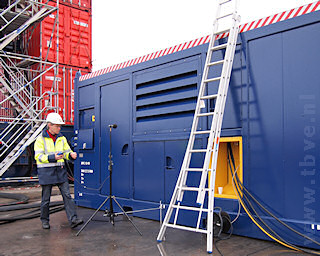
Sound specifications and noise requirements
A noise specification or requirement should be more than just a value expressed in decibel. A full description of what is meant
is always necessary: is it about sound pressure level, and if that's the case is this a surface average value, what shape
of the measurement surface is used, and what was the distance to the object? Maybe the sound power is used for a specification,
but the manual or brochure doesn't mention that and the dealer doesn't know.
A careful and expensive effort of an engineer, destroyed at the desk of a marketing or graphic design executive.
Case 1: generator package
For a client we investigated the sound pressure level of a hydraulic generator package.
The Machinery directive requires determination of the highest sound pressure level at any bystander
position, e.g. at 1,6 m height and 1 m distance.
For this package that so-called A-weighted emission sound pressure level was 85 dB, found close to a grid with a large fan behind it.
Consequently also the sound power level had to be determined.
Therefor the surface average A-weighted sound pressure level was measured and calculated. That appeared to be 77 dB,
also at 1 m distance.
Note the difference of 7 dB with the emission sound pressure level, both measured at the same distance!
For this client we made a Norsok compliant noise data sheet with clear description of all relevant values. The A-weighted sound power level of this machine is 98 dB.
Case 2: noise rating of an airco unit
Complaints about the split unit of an airco led to investigation of the factory specs. These appeared to be confusing and incorrect.
The brochure and the technical documentation stated a "noise level" of 52 dB(A). But "noise level" can refer to a lot of things.
Scrutiny of the detailed specifications reveals that the A-weighted sound pressure level (LpA) of the unit was 56 dB(A).
The "noise level" value of 52 appeared to be the noise rating level. Noise rating level has nothing to do with A-weighting and the (A) value mentioned in the brochure was incorrect.
A case of misleading information caused by ignorance or carelessness. Noise rating is a value obtained by comparing a spectrum with a collection of reference curves. The rating level corresponds to the
highest curve touched by the curve of the measured spectrum. Only by chance a rating value can be close to LpA.
This illustration explains the errors and the 4 dB confusion.
No mysteries
Noise measurement and specification is not a mystery, mysteries are created by carelessness and lack of knowledge.
We are eager to help avoiding discussions and confusion, and costs!
Read more